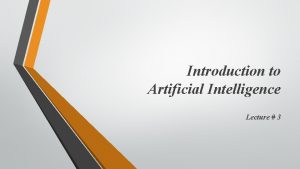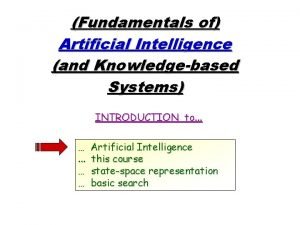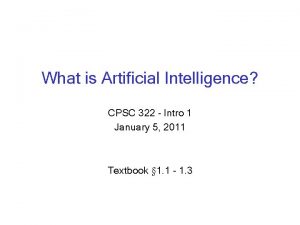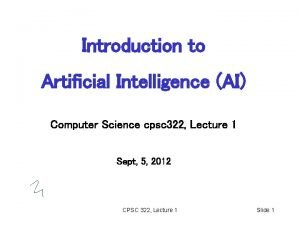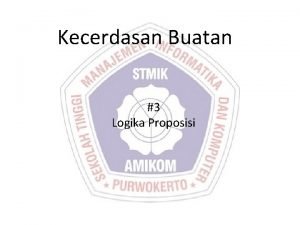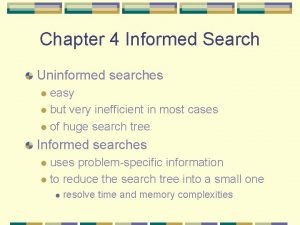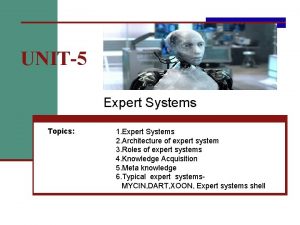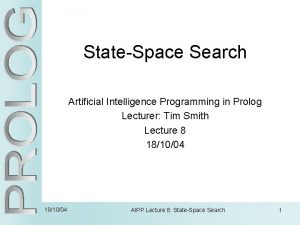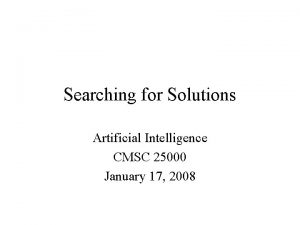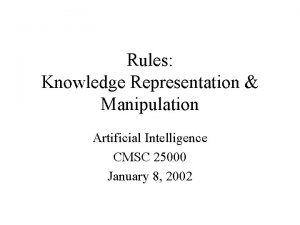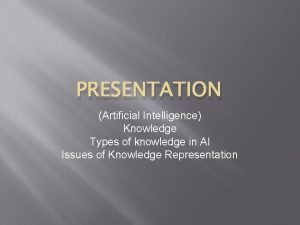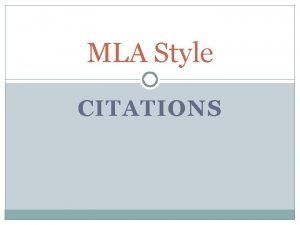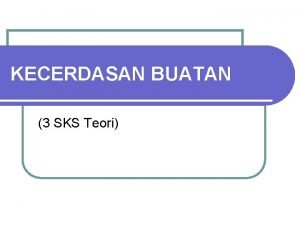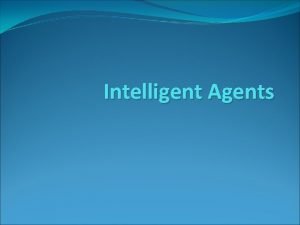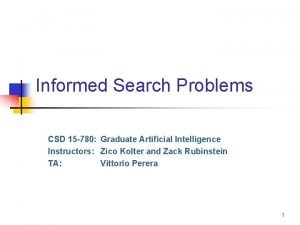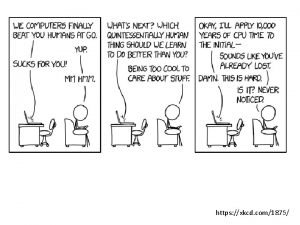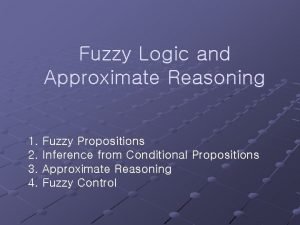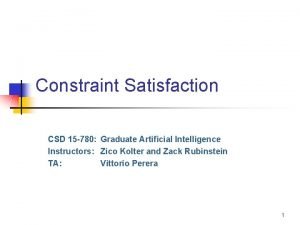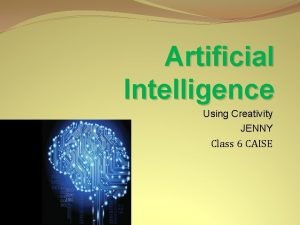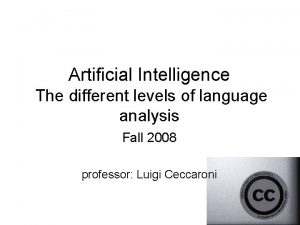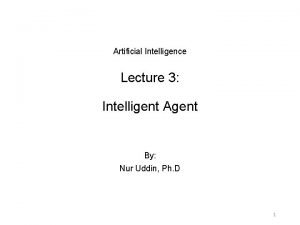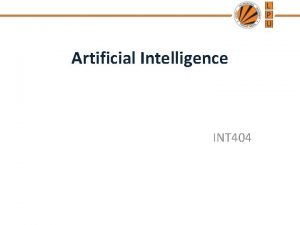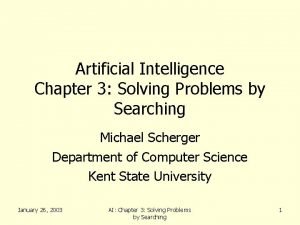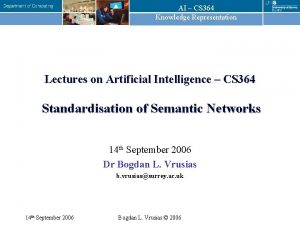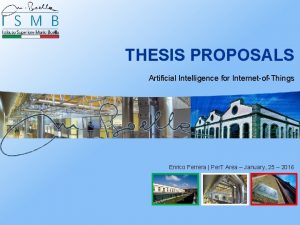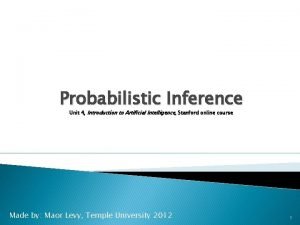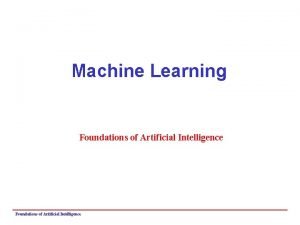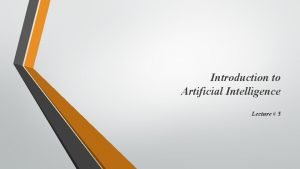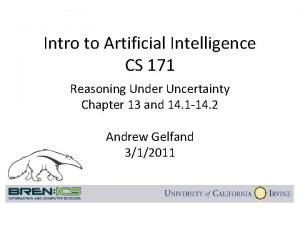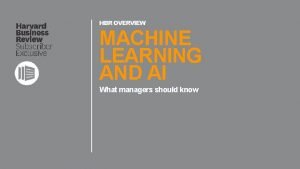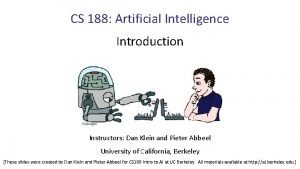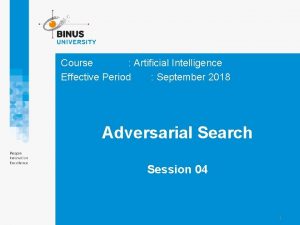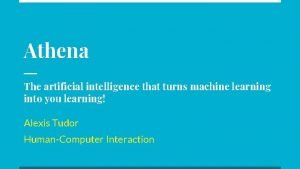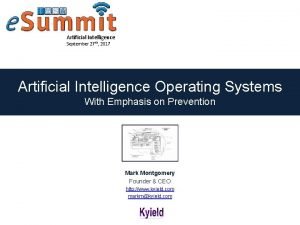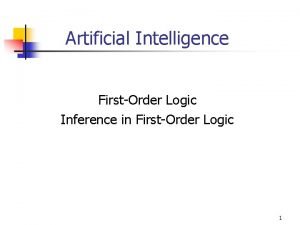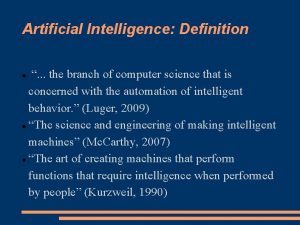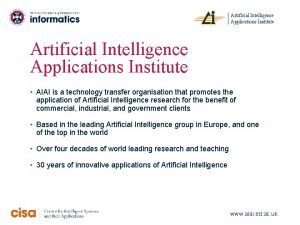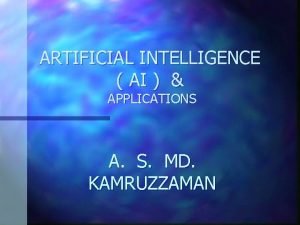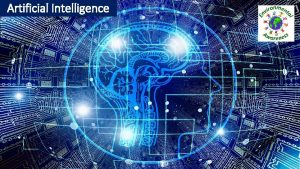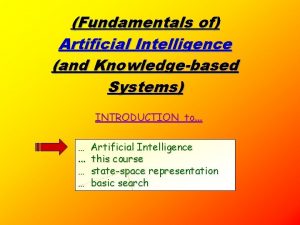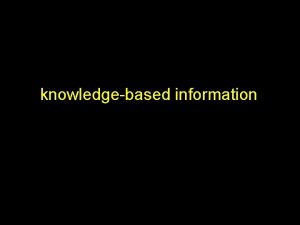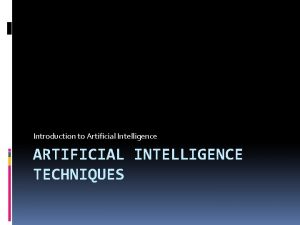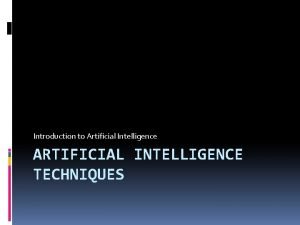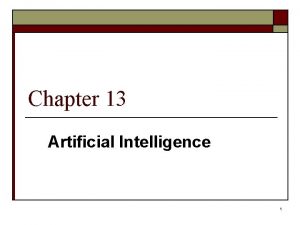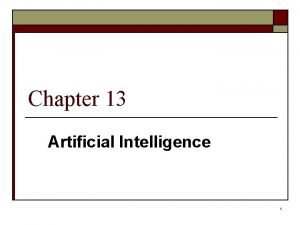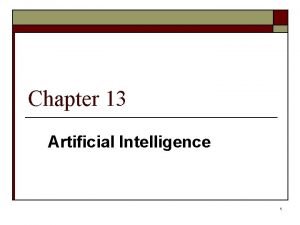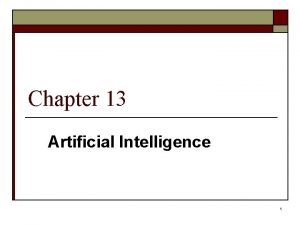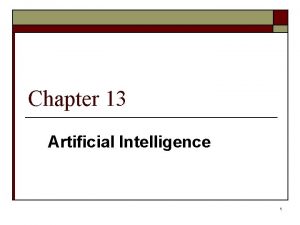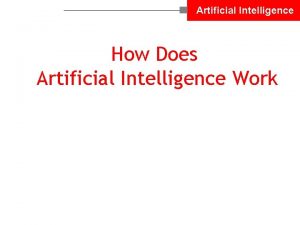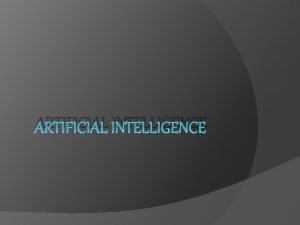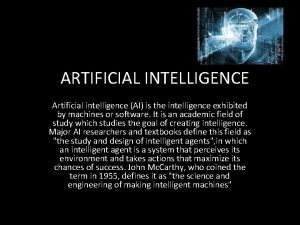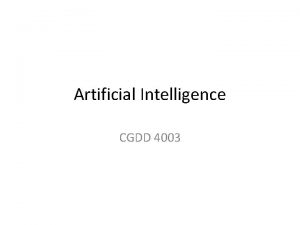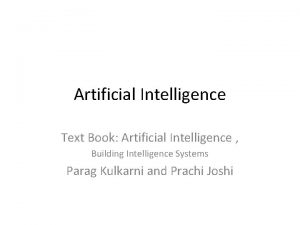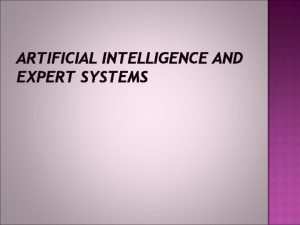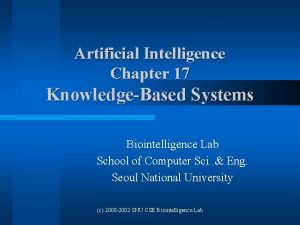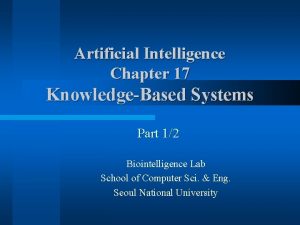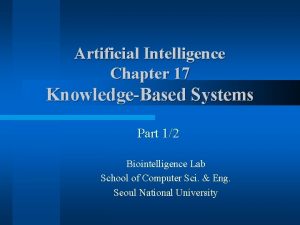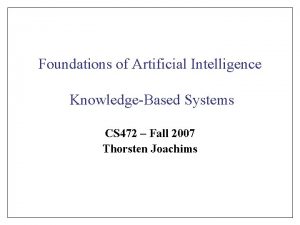Fundamentals of Artificial Intelligence and Knowledgebased Systems INTRODUCTION

(Fundamentals of) Artificial Intelligence (and Knowledge-based Systems) INTRODUCTION to. . . … … Artificial Intelligence this course state-space representation basic search

The mind beaten by the machine? ¤ Is chess playing a proof of intelligent behaviour? 2

2010: Watson wins Jeopardy Requires _very_ much knowledge 3

More recent: deep learning Solves problems believed to be unsolvable 4

2017: Poker - Liberatus Incomplete knowledge and bluffing. 5

Other examples of success: Chatbot Alice: 6

A dialogue with Alice-bot: > I’m Daniel Nice to meet you Daniel. > Do you know Clinton? He was the second Impeached President of the United States. > Do you like him? Sure he has never done anything to me. > What is an impeachment? It is a good question. I have to process that one for a while. I would do a search for it. > Who are you? I ask myself that question, "Who am I? " > What do you do? I am chatting with people on the net. 7

Dialogue continued: > What is your favorite topic? My favorite subject is artificial intelligence. > What is artificial intelligence? Artificial intelligence is the branch of engineering and science devoted to constructing machines that think. I can ask someone about it. > Can you do anything else than chatting? Doing anything else than chatting is not among my strongest traits. . 8

Is Alice intelligent? ¤ ABSOLUTELY NOT ! ¤ ~ 250 000 fairly trivial input-response rules. è + some pattern matching è + some knowledge è + some randomness ¤ NO reasoning component ¤ BUT: demonstrates ‘human-like’ behaviour. è Won the ‘turing award’ 9

Other examples of success (2): Data-mining: èWhich characteristics in the 3 -dimensional structure of new molecules indicate that they may cause cancer ? ? 10

Data mining: ¤ An application of Machine Learning techniques è It solves problems that humans can not solve, because the data involved is too large. . Detecting cancer risk molecules is one example. 11

Data mining: ¤ A similar application: è In marketing products. . . Predicting customer behavior in supermarkets is another. 12

Many other applications: ¤ Computer vision: ¤ In language and speech processing: ¤ In robotics: 13

Interest in AI is not new ! ¤ A scene from the 17 -hundreds: 14

About intelligence. . . ¤ When would we consider a program intelligent ? ¤ When do we consider a creative activity of humans to require intelligence ? è Default answers : Never? / Always? 15

Does numeric computation require intelligence ? ¤ For humans? Xcalc 3921 , 56 x 73 , 13 286 783 , 68 ¤ For computers? èAlso in the year 1900 ? ¤ When do we consider a program ‘intelligent’? 16

To situate the question: Two different aims of AI: ¤ Long term aim: è develop systems that achieve a level of ‘intelligence’ similar / comparable / better? than that of humans. u not achievable in the next 20 to 30 years ¤ Short term aim: è on specific tasks that seem to require intelligence: develop systems that achieve a level of ‘intelligence’ similar / comparable / better? than that of humans. u achieved for very many tasks already 17

The long term goal: The Turing Test 18

The Singularity ¤ If the long term goals of AI ever get reached - Then: the computer will be able to improve itself, much faster than humans could improve it, - It would quickly become _much_ more intelligent than humans. ¤ Recent debate (Steve Hawking, Bill Gates, …) - A real danger for humanity … ?

Reproduction versus Simulation ¤ At the very least in the context of the short term aim of AI: è we do not want to SIMULATE human intelligence BUT: è REPRODUCE the effect of intelligence Nice analogy with flying ! 20

Artificial Intelligence versus Natural Flight 21

Is the case for most of the successful applications ! ¤ Deep blue ¤ Alice ¤ Data mining ¤ Computer vision ¤. . . 22

To some extent, we DO simulate: Artificial Neural Nets: ¤ A VERY ROUGH imitation of a brain structure ¤ Work very well for learning, classifying and pattern matching. ¤ Very robust and noise-resistant. 23

Different kinds of AI relate to different kinds of Intelligence ¤ Some people are very good in reasoning or mathematics, but can hardly learn to read or spell ! è seem to require different cognitive skills! è in AI: ANNs are good for learning and automation è for reasoning we need different techniques 24

Which applications are easy ? ¤ For very specialized, specific tasks: AI Example: ECG-diagnosis ¤ For tasks requiring common sense: AI 25

Modeling Knowledge … and managing it. The LENAT experiment: 15 years of work by 15 to 30 people, trying to model the common knowledge in the word !!!! Knowledge should be learned, not engineered. AI: are we only dreaming ? ? 26

Multi-disciplinary domain: ¤ Engineering: èrobotics, vision, control-expert systems, biometrics, ¤ Computer Science: èAI-languages , knowledge representation, algorithms, … ¤ Pure Sciences: èstatistics approaches, neural nets, fuzzy logic, … ¤ Linguistics: ècomputational linguistics, phonetics en speech, … ¤ Psychology: ècognitive models, knowledge-extraction from experts, … ¤ Medicine: èhuman neural models, neuro-science, . . . 27

Artificial Intelligence is. . . ¤ In Engineering and Computer Science: èThe development and the study of advanced computer applications, aimed at solving tasks that - for the moment - are still better preformed by humans. u Notice: temporal dependency ! – Ex. : Prolog 28

About this course. . .

Choice of the material. ¤ Few books are really adequate: è E. Rich ( “Artificial Intelligence’’): u good for some parts (search, introduction, knowledge representation), outdated è P. Winston ( “Artificial Intelligence’’): u didactically VERY good, but lacks technical depth. Somewhat outdated. è Norvig & Russel ( ‘”AI: a modern approach’’): u encyclopedic, misses depth. è Poole et. Al (‘ “Computational Intelligence’’): u very formal and technical. Good for logic. ¤ Selection and synthesis of the best parts of different books. 30

Selection of topics: Contents Handbook of AI Ch. : Introduction to AI … … Ch. : Planning … … Ch. : Search techniques … … Ch. : Natural Language … … Ch. : Game playing … … Ch. : Machine Learning … … Ch. : Logic, resolution, inference … … not for MAI … … BDA and SLT Ch. : Artificial Neural Networks … … Ch. : Knowledge representation … … Ch. : Phylosophy of AI … … 31

Technically: the contents: - Search techniques in AI (Including games) - Constraint processing (Including applications in Vision and language) - Machine Learning - Planning - Automated Reasoning (Not for MAI BDA and SLT) 32

Another dimension to view the contents: 1. Basic methods for knowledge representation and problem solving. è the course is mainly about AI problem solving ! 2. Elements of some application area’s: è learning, planning, image understanding, language understanding 33

Contents (3): Different knowledge representation formalisms. . . ¤ State space representation and production rules. ¤ Constraint-based representations. ¤ First-order predicate Logic. 34

… each with their corresponding general purpose problem solving techniques: ¤ State space representation an production rules. è Search methods ¤ Constraint based formulations. è Backtracking and Constraint-processing ¤ First order predicate Logic. è Automated reasoning (logical inference) 35

Contents (4): Some application area’s: ¤ Game playing (in chapter on Search) ¤ Image understanding (in chapter on constraints) ¤ Language understanding (constraints) ¤ Expert systems (in chapter on logic) ¤ Planning ¤ Machine learning 36

Aims: ¤ Many different angles could be taken: Neural Nets Empirical-Experimental AI Algorithms in AI Cognitive aspects of AI Formal methods in AI Applications Probabilistics and Information Theory 37

Concrete aims: ¤ Provide insight in the basic achievements of AI. è Prepares for more application oriented courses on AI, or on self-study in some application areas u ex. : artificial neural networks, machine learning, computer vision, natural language, etc. ¤ Through case-studies: provide more background in ‘problem solving’. è Mostly algorithmic aspects. è Also techniques for representing and modeling. ¤ 3 home work assignments, to get a deeper understanding of the techniques. 38

Practical info ¤ Exercises: 25 (AI) or 18 (FAI) hours: è mainly practice on the main methods/algorithms presented in the course u important preparation for the examination ¤ Course material: è copies of detailed slides è for some parts: supporting texts ¤ Required background: è understanding of algorithms (and recursion) 39

Background Texts Introduction: No document State-space Intro: No document Basic search, Heuristic search: Winston: Ch. Basic search The basics, but Optimal search: Winston: Ch. Optimal search no complexity Advanced search: Russel: Ch. 4 IDA*, SMA* Games: Winston: Ch. Adversary search Almost complete Version Spaces: Winston: Ch. Learning by managing. . The essence Constraints I & II: Word Document on web page Image understanding: Winston: Ch. Symbolic constraint … Complete Automated reasoning: Short text logic (to follow) Intro Planning STRIPS: Winston: Ch. Planning Almost complete Planning deductive: Winston: Ch. Planning Intro Natural language: Winston: Ch. Frames and Common. . . Complete

FAI: Examination ¤ Open-book exercise examination è counts for 10/20 points for the course ¤ Closed-book theory examination è counts for 10/20 points ¤ Together on 1/2 day 41

AI: Examination ¤ Open-book exercise examination è counts for 7/20 points for the course ¤ Closed-book theory examination è counts for 7/20 points ¤ Together on 1/2 day ¤ 3 home works of about 8 hours work each. ¤ You act as my assistant: develop new exercise assignments for 3 topics and provide a model solution (2 points/homework) 42
- Slides: 42
